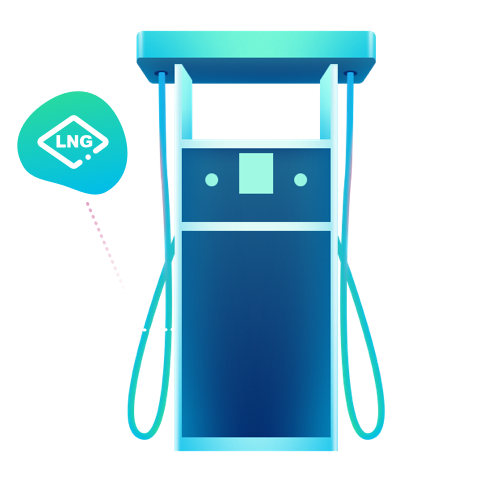
It allows to substantially eliminate particulate matter (-97% PM) and reduce emissions of nitrogen oxides (-75% Nox) and carbon dioxide (-33% CO2) compared to a petrol car.
Source: EMPAReport, ADAC
Thanks to their "eco" feature, CNG cars can circulate more freely in city centres.

Natural gas combustion is 50% quieter than Diesel engines, helping to reduce noise in the city.

Considering a mileage of 12,000 km per year, it allows a saving estimated at over 500 euros per year compared to a gasoline car*, with a fuel saving of up to 60%**.
Source: *Adac, **Ecomotori
| It has a very good yield and low travel costs: with a CNG car you can go further and spend less. |

For cars at CNG there are significant reductions or even exemptions on car ownership taxes.

| The motorist who chooses the CNG is protected by high safety standards and thorough testing |

| CNG cylinders can be of various types depending on the material and the different volume and space requirements, with guarantees of resistance. All are equipped with safety valves that minimize the risk of accidents. |

| There are no restrictions on parking for CNG cars. |

CNG/LNG stations
in Italy

CNG/LNG stations
in Europe

vehicles registered
in the last year

Liquefied Natural Gas (LNG) is the immediate solution for decarbonising heavy transport. This alternative fuel allows long distances at reduced costs, drastically reducing polluting emissions (-99% PM10, -60% NOx) and climate-changing emissions (-15% CO2).
Source: IVECO, Snam
For the same amount of energy supplied it is cheaper than diesel, emits less noise and achieves the same performance and driveability. Liquefied gas can also supply ships and trains, favouring the decarbonisation of maritime and rail transport, and can also be renewable (bio-LNG), contributing to the management of waste in a circular economy.
CNG is an acronym that means "compressed natural gas", compressed natural gas. It identifies natural gas for transportation, an alternative and more environmentally friendly fuel than traditional fuels, which can power cars, trucks and buses. With its consolidated technology in the world, Italy is the leading European market for natural gas mobility, with over 1 million vehicles currently in circulation and a widespread and growing distribution network.
Considering a mileage of 12,000 km per year, it allows a saving estimated at over 500 euros per year compared to an equivalent petrol engine. Compared to a gasoline car, fuel savings can be up to 60%.
To find a complete map of all working CNG/LNG stations click here.
The map will highlight the "self-ready" refueling stations as soon as they are reported to us.
Yes. One of the most important advantages of using CNG as an alternative fuel for motor vehicles is certainly the protection of the environment: natural gas produces significantly less CO2 (down to -30%), the cause of the greenhouse effect, and drastically reduces emissions more harmful to health,PM (-97%) and Nox (-74%). With biomethane, a 100% renewable gas obtained through the processing of biomass, such as organic waste or agricultural and agro-industrial waste, CO2 emissions are reduced to zero and natural gas mobility becomes even more sustainable.
Yeah. Natural gas mobility is partly renewable thanks to biomethane, which already flows in the Italian gas pipeline, with quantities destined to grow in the future, leading to further mobility decarbonisation. Thanks also to the incentives for transport use, by 2022 the CNG provided by Italian service stations could be 30% biomethane.
Thanks to the very low emissions of local pollutants (PM and NOx), CNG vehicles enjoy special benefits both in terms of car taxes and access to historic city centres or restricted traffic areas. Every local reality, however presents its typical features: it is always useful to inquire through the website of your municipality.
CNG and LPG are often confused with each other and identified in a generic way as "gas for transportation", but the differences are manifold. The CNG, or gas natural, as its definition says, must not be produced because
is already found in nature and is composed for the most part of methane, which afterwards a purification process is used as fuel.
LPG is a gas derived from the oil processing: a mixture of fuels, mainly propane and butane, and subproducts of the process of crude oil refining.
To know when the CNG cylinder overhaul is to be carried out, it'snecessary to check whether the cylinders have been approved according to the national legislation (R110 ECE/UN) or according to the European legislation R110 ECE/UN. For cylinders approved in accordance with national regulations (DGM), the overhaul of the car's CNG system must be carried out every five years. For cylinders approved according to the European standard R110 ECE/ONU, the deadline of the overhaul depends on the construction material: if the cylinders are made entirely of steel (CNG1), steel with resin reinforcement belt (CNG2) and steel with complete synthetic coating (CNG3) the control goes done every four years. Instead, for composite fibre cylinders (CNG4), the first overhaul should be done every four years and the next every two. On the website www.ilportaledellautomobilista.it you can find all the information about the types of CNG cylinders, their periodic checks, the regulations and the various in-depth studies.





